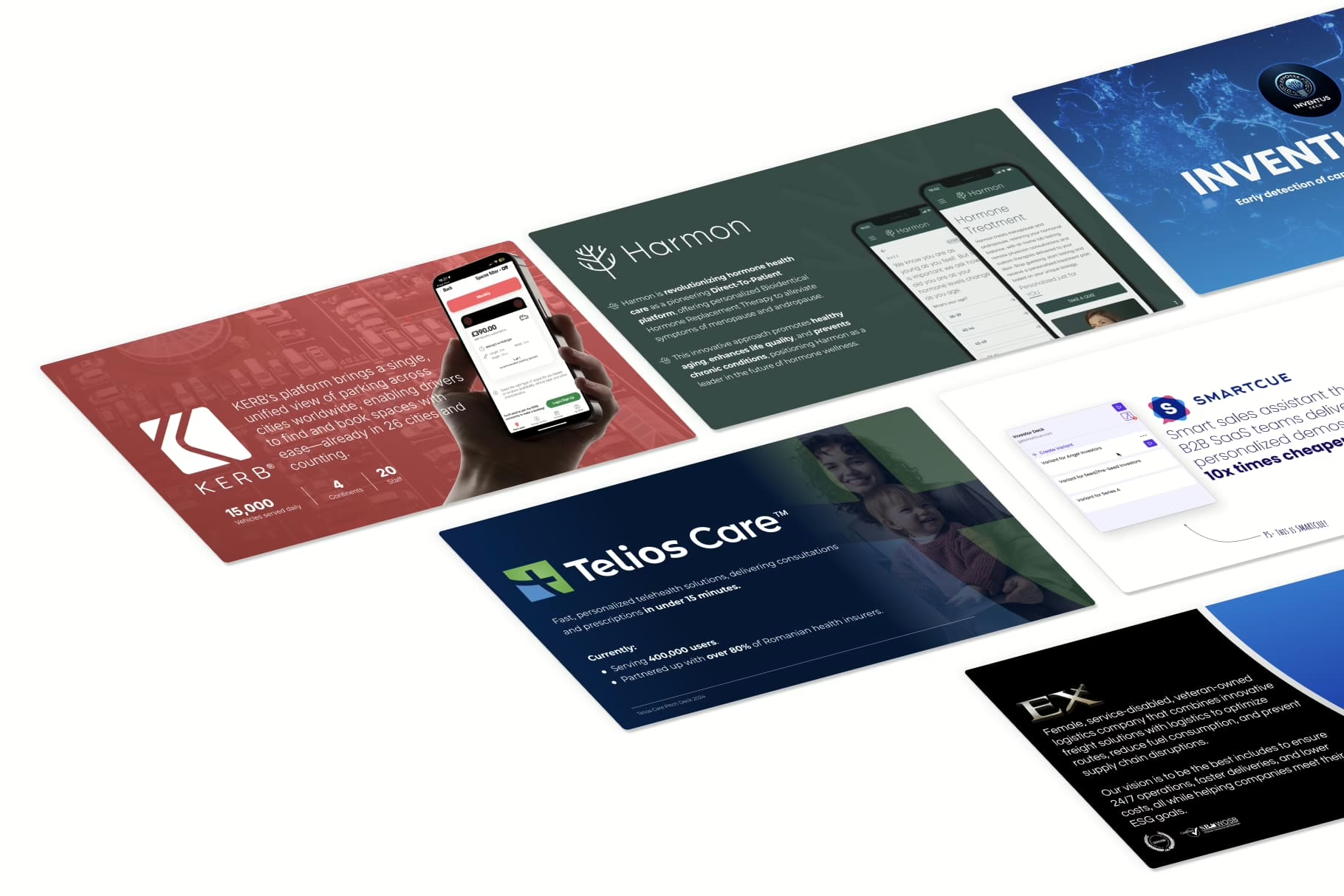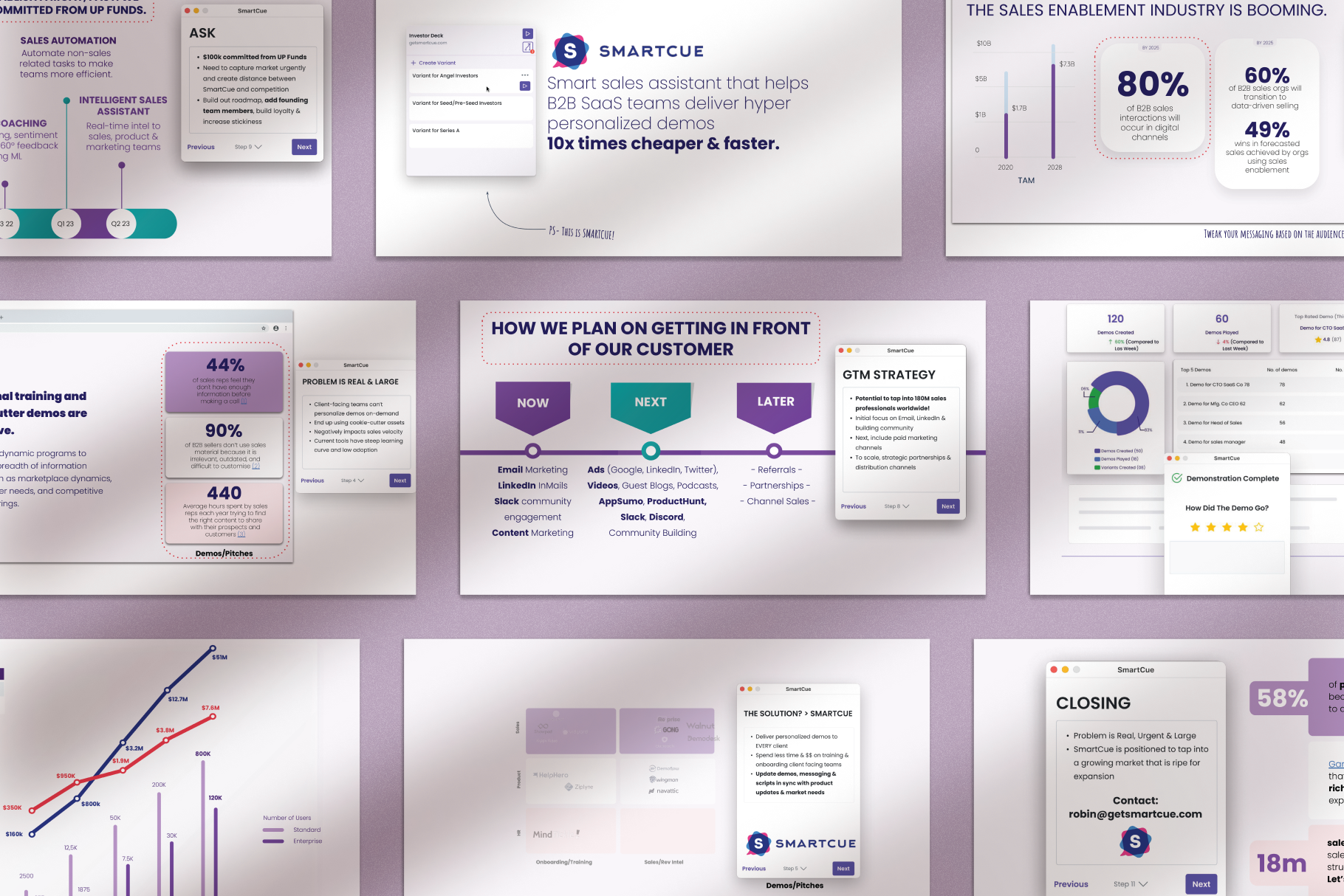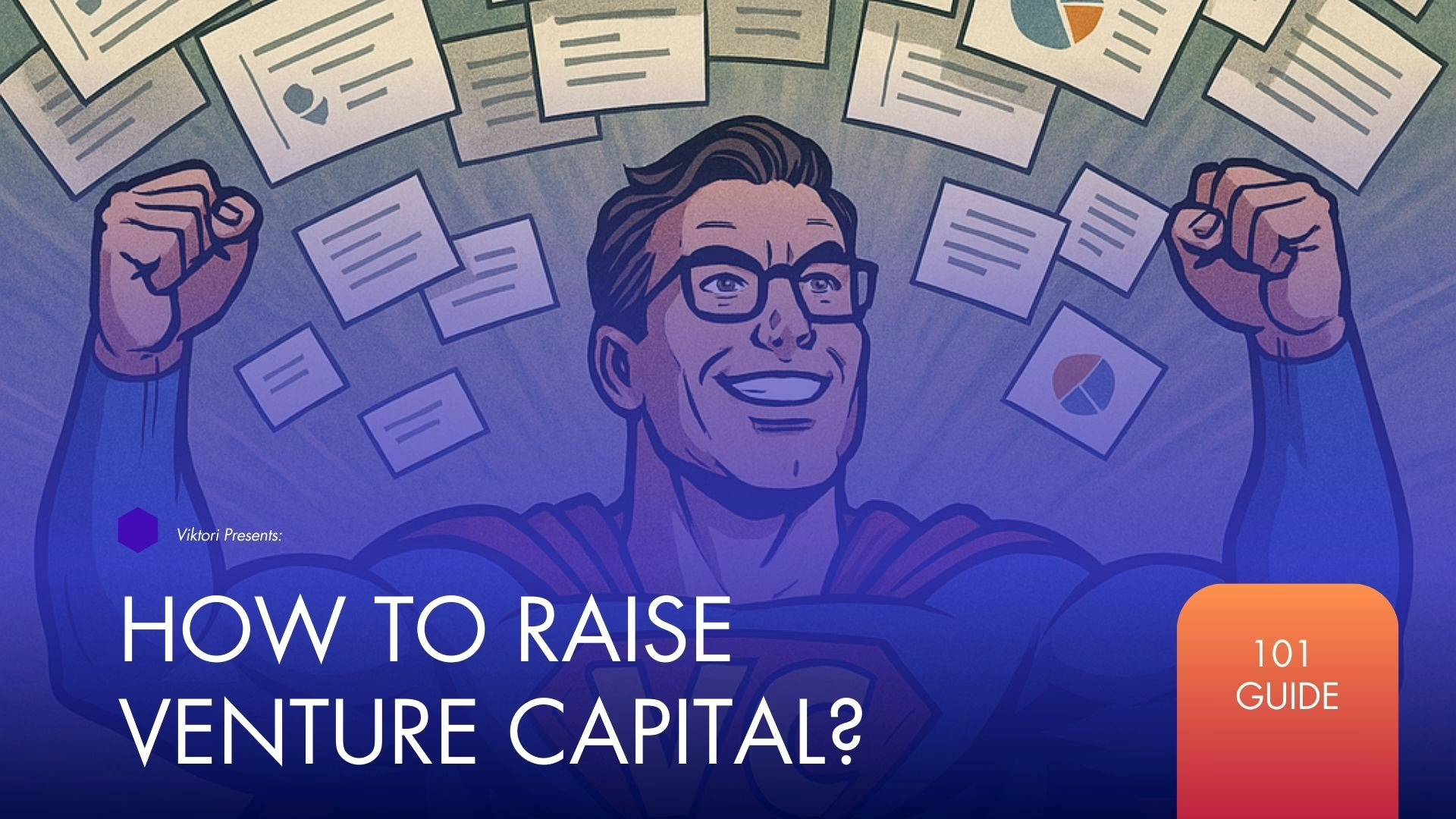How to Raise Venture Capital: A Startup Guide to Winning Over VCs

Author: Viktor
Pitch Deck Expert. Ex Advertising. Founder of Viktori. $500mill In Funding. Bald Since 2010.
Before we dive into VCs and raising capital, a quick story…
Since I was a kid, I’ve been obsessed with understanding how things really work. Not just the surface-level stuff, but the mechanics underneath. I used to take apart anything I could get my hands on—radios, watches, my dad’s tools—and try (not always successfully) to put them back together.
Quick story: One summer, my cousin and I “strategically dismantled” an old Vespa my uncle gifted us. We had no master plan. We just wanted to understand what made it tick. Well, we sure found out… and let’s just say that Vespa ended up as parts in my uncle’s barn, rather than on the road.
Fast forward to my professional life—working at New Moment New Ideas Advertising, scaling global projects at Valoso, and later, running my own consultancy—I’ve seen startups and seasoned companies alike make a familiar mistake.
At first, they shine. They pitch. They attract attention. They maybe even close a seed round or land a feature in TechCrunch.
Then… plateau.
Some start losing traction. Others burn through cash. Some fade out completely while competitors surge ahead.
I kept wondering:
Why were some startups thriving while others were flatlining?
Why were incredibly smart, well-funded entrepreneurs with top-notch teams still failing to raise capital in follow-up rounds or even survive?
After years of watching this cycle, I realized the pattern.
It wasn’t a lack of vision, talent, or even market opportunity.
It wasn’t that they didn’t raise capital early on—they often did.
The problem?
They didn’t know how to frame their story the right way, especially when it came to venture capital fundraising.
I’m not talking about fluff or manipulation—I’m talking about understanding how venture capital firms actually think. What they value. How they make decisions.
And most importantly: How to make them feel like investing in you is inevitable.
What Happens If You Skip This?
You keep pitching the wrong way.
You keep hearing polite “no’s” or worse—no response at all.
You stay stuck thinking it’s the market, or timing, or “VCs just don’t get it.”
When the truth is, you never learned how to frame the conversation properly.
I’ve been there. I’ve coached founders who’ve been there.
And every time they fixed this one thing, they didn’t just raise capital—they unlocked the kind of growth that turns small startups into giants.
In this guide, I’ll show you:
How the best founders craft a winning narrative
What VCs actually care about
And how to navigate every step of the fundraising stage like a pro
No fluff. No outdated MBA jargon.
Just a practical, tested approach that I’ve used to help founders raise millions, even in down markets.
Let’s get to it.
Understanding Venture Capital
At its core, venture capital (VC) is a powerful engine that fuels the startup ecosystem. It’s a type of private equity investment designed to help early-stage startups—especially those with scalable business models—raise capital to innovate, expand, and dominate their markets.
How Venture Capital Works
A venture capital firm doesn’t just hand out checks. It operates as a professional investment entity, managing one or multiple VC funds raised from limited partners (LPs) such as institutional investors, family offices, or high-net-worth individuals. These venture funds are typically structured to last 10 years, with the first few years focused on investing and the remainder on managing, growing, and exiting portfolio companies.
The vc firm’s mission? Generate a high return on investment (ROI)—often through IPOs, strategic acquisitions, or secondary sales. To achieve that, venture capitalists evaluate dozens of investment opportunities weekly, choosing only the ventures that align with their investment thesis, funding stage, and potential to become a successful venture.
When a startup raises money from a VC, it typically gives up equity in exchange for the funds. This ownership stake represents the VC’s capital investment, but more importantly, it gives them a say in the company’s growth trajectory, often through board seats and an active role in strategic decisions.
Why VC Is Different from Traditional Funding
Unlike traditional debt financing—where banks look at assets, credit history, and repayment ability—venture capital investors bet on potential. They invest in entrepreneurs, bold ideas, and business plans that can scale exponentially. In return, they expect equity and a long-term stake in the upside.
This is where institutions like Silicon Valley Bank come into play. While they do provide loans and financial infrastructure, they also act as strategic partners, often collaborating with VC firms to support startups during critical growth phases like the seed stage, series A round, or series B funding.
The Role of VC in the Fundraising Process
From pre-seed funding to late-stage series rounds, VC plays a crucial role in the fundraising process. Here’s how it fits into the broader funding journey:
Pre-Seed/Seed Stage: Entrepreneurs need initial capital to validate their product or service. This often comes from angel investing, friends and family, or pre-seed VCs.
Series A Round: At this investment stage, the startup typically has some traction and needs capital to scale. VCs look for product-market fit, early revenue, and a defensible business model.
Series B and Beyond: Series B funding enables startups to expand across markets, build out teams, and improve operations. These later rounds of funding attract larger vc firms, lead investors, and sometimes corporate VCs.
What Venture Capitalists Look For
When VCs raise a new fund, they’re making a long-term bet on emerging trends and sectors. As such, they vet startups rigorously. Key evaluation points include:
Strong, committed founders
A scalable business model
Compelling market opportunity
Sound valuation
A clear path to a return on their investment
They also want to see that you can demonstrate traction, articulate your funding needs, and align with their investment strategies.
Why Startups Raise Venture Capital

Every ambitious startup eventually reaches a point where personal savings, credit cards, and even early revenue are no longer enough. That’s when founders start to look to raise venture capital—not just as a funding source, but as a strategic accelerant to unlock growth, gain credibility, and execute faster than competitors.
When Entrepreneurs Should Raise Capital
Here’s when entrepreneurs typically pursue venture capital funding:
1. Capital Needs Exceed Bootstrapping Capacity
Some businesses—especially in sectors like biotech, AI, and SaaS—require a significant amount of capital early on to develop products, build infrastructure, and acquire users. Capital typically needed at this stage goes far beyond what a founder can self-finance or borrow.
2. Rapid Scaling is Crucial for Competitive Advantage
In fast-moving industries, being first isn’t just nice—it’s everything. If your business model requires user acquisition, market penetration, or network effects, vc money allows you to scale aggressively and beat slower-moving rivals.
3. Access to Strategic Capital, Mentorship & Networks
Today’s venture capital firms bring more than checks. The right vc fund offers domain expertise, access to industry experts, fund managers who guide your growth strategy, and connections to future investors, talent, and partners. For many early-stage startups, this guidance is just as valuable as the money.
Key Benefits of Raising Venture Capital
When you raise capital from a venture fund, you unlock several advantages that traditional financing options simply can’t match:
Working Capital to Hire, Build, and Market
Funds from a seed round, series A funding, or series B are often used to recruit top talent, expand tech stacks, execute go-to-market plans, and improve your product.Enhanced Credibility with Stakeholders
Being backed by a respected vc firm can increase investor interest, attract stronger hires, and open doors to customers or distribution partners. Especially when firms are associated with players like Silicon Valley Bank, your startup becomes instantly more legitimate in the eyes of the ecosystem.Faster Product Development & Iteration
Founders need to move fast. With sufficient capital, you can build features, gather feedback, iterate, and improve in compressed timeframes—essential in the race for product-market fit.
The Risks You Must Consider
Raising venture capital comes with its own set of trade-offs. These include:
Dilution of Ownership and Control
Every funding round dilutes the founder’s equity. From the first round of venture capital to later investment rounds, you trade control for capital. While necessary to grow, it’s important to maintain enough stake and say in your vision.Pressure to Hit Investor-Driven Milestones
VCs want to invest in companies that can return 10x or more. That means you’ll need to demonstrate growth, hit revenue targets, expand your team, and constantly justify your valuation. The investment committee is always watching—and the pressure to perform can be intense.Expectation of Future Fundraising
When you accept VC funding, you’re implicitly agreeing to raise a series of rounds. The expectation is that you’ll either raise money again soon, or scale to an exit within a set timeline. This influences everything from hiring to product roadmap decisions.
Strategic Capital vs. Just Money
It’s not just about getting the capital right—it’s about getting the right capital.
Does the venture capital firm align with your mission?
Do they understand your market and investment stage?
Can they provide more than cash—such as intros, board guidance, or operational support?
Some venture capital investors bring tremendous value; others may push you into growth at all costs, even before you’re ready. Choose your backers like you would choose a co-founder.
The 12 slide pitch deck framework that got my clients $500m in funding.
I’ve developed 12 simple formulas that will save 40 hours of your time and show you how to craft content that makes investors invest.
Start using these formulas by downloading my detailed framework through the link below. Promo price available for the first 40 buyers. Few downloads remaining.
When to Raise: Fundraising Stages Demystified
One of the most important questions a startup founder can ask is: When should I raise capital? Timing in the fundraising process is everything. Raise too early, and you risk unfavorable terms or premature dilution. Wait too long, and you might run out of runway. Understanding the different fundraising stages—from pre-seed funding to Series B—is essential to making smart investment decisions and aligning with the right venture capital firm at the right time.
Each stage of venture capital funding serves a distinct purpose in the lifecycle of a startup. Here’s a breakdown of what each round typically looks like:
| Stage | Typical Raise | Focus | Key Metric |
|---|---|---|---|
| Pre-Seed | $50K–$500K | MVP validation & early discovery | Problem-solution fit |
| Seed Stage | $500K–$2M | Achieving product-market fit | Early revenue, usage metrics, or initial traction |
| Series A | $2M–$15M | Scaling operations and customer acquisition | Proven business model and repeatable sales process |
| Series B | $10M–$50M | Market expansion and organizational growth | Revenue growth, team scaling, and unit economics |
Pre-Seed: Testing the Waters
Often backed by angel investors, accelerators, or early believers, the pre-seed stage is where many entrepreneurs start their journey. It’s typically about building a minimum viable product (MVP), conducting customer discovery, and laying the groundwork for your startup’s future.
At this stage, venture capital firms are rare, but some pre-seed VC firms and micro-vc funds have emerged that specifically invest in startups this early. The key is to show that you deeply understand the problem, and that your team has the ability to execute.
Seed Stage: Proving Product-Market Fit
The seed round is when you’re expected to validate your solution with real users. Whether it’s B2B SaaS or consumer tech, seed funding is used to refine your product or service, test go-to-market strategies, and gather evidence that people want what you’re building.
This is often the first round where serious venture capital investors come in. A solid team, early customer interest, and an actionable roadmap help spark investor interest. It’s also where having seasoned advisors can bolster confidence among venture firms.
Series A: Building a Scalable Engine

Series A funding is about turning promise into performance. By this stage, your startup should have a working product, paying users, and a clear business model that can scale. VCs raise capital for their funds specifically to back companies that are ready to expand operations.
Investors will look for:
Consistent traction
Evidence of scalable sales channels
Thoughtful unit economics
A clearly defined growth plan
This is also where venture capital firms start to pool in bigger checks, often with a lead investor taking board seats and shaping long-term strategy. Institutions like Silicon Valley Bank might provide venture debt or other financial infrastructure alongside VC support.
Series B: Expanding Into New Markets
If Series A proves the engine works, Series B pours gas on the fire. At this fundraising stage, startups need to grow rapidly, expand teams, optimize systems, and enter new markets. You’re no longer validating the business model—you’re operationalizing it.
A Series B round often includes participation from existing investors and larger venture capital firms who specialize in later-stage deals. It’s common to see vc funds and even corporate venture arms contributing capital at this stage.
What VCs Look for at Every Stage
Regardless of the round, venture investors evaluate:
Milestone alignment with stage-specific expectations
A compelling narrative that supports the next raise
The right use of funds for hitting new growth goals
A vision that supports kinds of returns expected in venture portfolios
For VCs, each round is a bet—not just on the startup, but on the team’s ability to deliver outsized results. To attract the right backers, founders must demonstrate clarity on where the money goes and what success looks like.
Timing Isn’t Just Financial—It’s Strategic
Remember: raising funds isn’t just about needing money—it’s about accelerating the right things at the right time. Whether you’re securing initial capital or gearing up for series B funding, the best founders start to look for funding before they need it. That foresight signals confidence and control, two traits every top-tier vc firm wants to see.
Crafting a Winning Pitch Deck
In the venture capital world, a pitch deck is more than just a slide deck—it’s a narrative designed to raise capital, win trust, and ignite excitement. As a startup entrepreneur, you’re not just sharing data; you’re sharing belief. A pitch that lands isn’t just informative—it’s transformative.
Whether you’re preparing for a seed round, Series A, or a strategic meeting with a venture capital firm, your pitch deck must align with the expectations of today’s vc investors. Let’s break down the anatomy of a compelling, investor-ready deck.
1. Name the Enemy
Start strong. Introduce the problem your startup solves by clearly naming the “enemy.” Whether it’s climate change, outdated infrastructure, or broken user experiences—make it real, relatable, and visceral.
“Fossil fuels are killing the planet. We’re here to fix it.”
This slide anchors your story in something that matters. It shows the venture capital investors why your product or service is worth their time, attention, and capital.
2. Create Urgency
Why now? Why is this problem at a tipping point?
Use data, emerging trends, regulatory shifts, or user behavior to show that this is the moment to act. This creates investor interest and helps position your startup as part of a current, unstoppable wave. Venture capital funding is all about timing, and urgency shows you understand the market dynamics.
3. Present a Unique Solution

Now that you’ve defined the problem, present your startup as the “missing puzzle piece.”
What makes your solution different from everything else?
Is it proprietary tech, a powerful network effect, or a unique business model?
This is where many founders fail—by focusing on features over benefits. Show the before and after—and always visualize the impact.
4. Explain Your Business Model
A brilliant product means little without a clear business model. Investors want to know:
How do you make money?
Is it subscription-based, freemium, SaaS, transactional, marketplace?
Show that you’ve thought through the economics and can scale sustainably. The vc firm sitting across from you is calculating whether your revenue model can support venture-scale growth.
5. Showcase Team Credibility
Venture firms invest in people. Your startup’s founding team should demonstrate:
Domain expertise
Execution history
Complementary skill sets
Highlight past successes, relevant experience, and why this team is uniquely qualified to win. VCs often say, “We back jockeys, not horses.” Make it clear why you’re the right team to bet on.
6. Go-to-Market Strategy
How are you going to acquire your first 1000 customers?
Detail the channels, tactics, and sales motions. Whether it’s B2B outbound, paid ads, SEO, partnerships, or influencer marketing—your go-to-market plan should demonstrate traction, focus, and a data-informed approach.
This shows you’re not just building a great product—you’re building a business.
7. Market Size: TAM/SAM/SOM
Venture capital firms only back ideas with venture-scale potential. Use the TAM/SAM/SOM framework:
TAM: Total Addressable Market
SAM: Serviceable Available Market
SOM: Serviceable Obtainable Market
Include third-party data sources, Silicon Valley Bank reports, or market research to validate. Use charts to visualize and keep things digestible.
9. The Ask: How Much and Why
This is your moment. Be specific about:
How much capital you’re raising
What the funds will be used for (hiring, product, marketing, etc.)
What it unlocks (e.g., 18-month runway, hitting $1M ARR, entering new markets)
This slide shows you’ve done your homework. It also signals that you understand how to deploy capital right—a major concern for any vc fund considering your deal as part of the fundraising process.
Understanding VC Psychology
If you want to successfully raise capital from a venture capital firm, you must understand a core truth: VCs are human. Behind the spreadsheets, pitch decks, and term sheets are people driven by instincts, emotions, and mental shortcuts—just like the rest of us.
This is where insights from Pitch Anything by Oren Klaff and The Great Mental Models by Shane Parrish become game-changers for any entrepreneur. These works emphasize something many founders overlook: who controls the frame, controls the deal.
In the boardroom, frame control isn’t a gimmick—it’s a necessity.
Frame Control: The Unspoken Power Dynamic
Venture capitalists sit through hundreds of pitches each year. Many blur together. What separates those who receive funding from those who don’t often comes down to who holds the strongest frame.
A frame is the mental structure through which someone views the world. VCs bring their own: one shaped by experience, pattern recognition, and gatekeeping capital. If you enter the room already submitting to their frame, you’ve lost. But if you hold your ground, confidently frame your startup as an opportunity they don’t want to miss—you flip the dynamic.
How to Control the Narrative
Here’s how high-performing founders command attention and shift power during the fundraising stage:
1. Status Alignment: Be Their Equal
Don’t grovel. Don’t pitch like you’re begging to be chosen.
Walk into the room as a peer—not as someone asking for money, but as someone offering a rare investment opportunity. VC firms respect founders who demonstrate clarity, control, and conviction.
If you’ve done the homework, validated your idea, and know your business model inside out, show it. Confidence (not arrogance) creates status alignment and sets the tone for mutual respect.
2. Frame Your Deal as Scarce and Time-Sensitive
VCs know that pool money only goes to a few promising startups in any given vc fund cycle. Use that truth to your advantage.
Position your deal as:
Limited in access (“We’re speaking to just a few aligned investors.”)
Fast-moving (“We’re finalizing our seed round this quarter.”)
Competitive (“We’ve already had interest from other venture firms.”)
Scarcity triggers urgency—and urgency drives investment decisions.
3. Eradicate Neediness
Neediness kills deals. Whether you’re raising funds or securing a second meeting, the vibe you give off matters more than you think.
VCs are wired to back founders who don’t need them, but choose them.
The subtext of your pitch should be: “We’re building something inevitable. We’d love to partner with you—but we’re moving forward regardless.”
This signals that you have options, you respect their time, and you know how to raise capital the right way.
Think Like a VC
Put yourself in the mindset of a venture capital investor:
They’re measured by their ability to pick winners.
They’re allocating limited capital across hundreds of pitches.
Their reputation with their own fund managers and limited partners is on the line.
They want deals that feel like they’re slipping away. They want startups that have traction, momentum, and entrepreneurs who own the room.
So the next time you walk into a pitch, remember: You’re not just funding your startup—you’re framing a high-return opportunity.
Due Diligence: What VCs Check
Securing a meeting with a venture capital firm is just the beginning. Even if your pitch is compelling and your startup is gaining traction, the real test begins during due diligence—a critical phase of the fundraising stage where vc firms validate everything you’ve claimed.
This is the part of the process where venture capitalists move from storytelling to fact-checking. Their job? Protect the interests of their vc fund, their fund managers, and ultimately, the limited partners who have trusted them to allocate capital wisely.
If you want to receive venture capital, you need to pass this scrutiny with flying colors.
What VCs Dive Into During Due Diligence

Here’s what every serious venture capital firm will investigate before they wire funds and finalize their capital investment:
1. Legal Structure and Cap Table
Is your entity clean and structured for venture capital funding?
Do you have all the necessary founder agreements, equity splits, SAFEs or convertible notes clearly documented?
Has equity been properly allocated, or are there unresolved claims?
Your cap table (capitalization table) needs to show exactly who owns what—transparently and without surprises.
2. Evidence of Product-Market Fit
VCs want proof that the market wants what you’re building.
This could be:
Active users or paying customers
Waitlists or MRR growth
Customer testimonials or churn analysis
At the seed round, this may be minimal, but by the time you raise capital in later stages, you’ll need stronger validation. Your job is to demonstrate that you’re not just building a product—you’re solving a real problem for real people.
3. Customer Acquisition Strategy
Even with great product-market fit, if you can’t attract users, your business model collapses.
VCs will analyze:
CAC (Customer Acquisition Cost) and LTV (Lifetime Value)
Growth channels (paid ads, SEO, partnerships, outbound, etc.)
Go-to-market efficiency and funnel conversion metrics
This helps investors assess how scalable your growth is and whether you’ve found a repeatable model for customer acquisition—a key milestone before raising funds beyond seed stage.
4. Financial Projections: Aspirational but Grounded
Don’t overpromise—and never underprepare.
Venture firms expect:
3–5 years of financial projections
Detailed assumptions behind your revenue, margins, and cost structure
A reasonable path to profitability or a compelling story for long-term growth
Projections are not about precision—they’re about how you think. They show your understanding of key startup metrics and your ability to manage money when you do raise capital.
5. Your Data Room: Organized, Accessible, Trustworthy
A clean, professional data room accelerates trust. Include:
Profit & Loss (P&L) statements
Balance sheets and cash flow forecasts
IP agreements and trademarks
Customer contracts (if any)
Hiring plans and org charts
Decks, roadmaps, and market research
If you want to fund your startup with VC money, you need to show you’ve done the work. Organized documentation signals a founder who takes investment seriously.
Make It Easy for VCs to Say Yes
Your job during due diligence is to remove friction. Make their internal conversations easy. Give them everything they need to go to the investment committee with confidence.
Remember: The fastest path to raise venture capital is not just a great pitch—it’s a great foundation.
And if your funding partner is a forward-leaning institution like Silicon Valley Bank, they may require additional compliance or financial review steps to complement VC involvement.
Where to Find VCs
One of the biggest myths in the startup world is that all venture capital lives in Silicon Valley. While it remains a major hub, today’s vc firms are spread across cities, sectors, and even continents. The rise of remote investing, thematic venture funds, and industry-specific backers means entrepreneurs have more options than ever to raise capital.
If you’re looking to receive venture capital, you need to go beyond Google searches. It’s about targeting the right funding source for your stage, sector, and story.
1. Local VC Firms and Micro VCs
Many cities now have thriving startup ecosystems supported by local vc firms and micro-funds. These vc firms often specialize in early-stage investing, writing checks between $100K–$1M for seed rounds and pre-seed opportunities.
Benefits of working with local investors:
Easier face-to-face interaction
Stronger ties to regional talent, mentors, and media
Often more hands-on support for first-time founders
Start your search by mapping out venture capital firms near your startup’s HQ or product market.
2. Angel Investor Networks

Before you reach institutional VCs, consider raising from angel investors. These are high-net-worth individuals who fund startups at the riskiest stage, typically before there’s traction or revenue.
Top networks to explore:
AngelList – A massive directory of startups and angel investors.
Local angel syndicates
Industry-specific angel groups (e.g., healthcare, fintech, clean energy)
Angels often raise capital alongside vc firms or serve as bridge investors between funding rounds.
3. Strategic Investors & Corporate VC Arms
Corporations now operate their own venture funds to stay close to innovation. Known as corporate VCs or “CVCs,” these strategic partners invest in companies aligned with their long-term vision.
Examples include:
Google Ventures (GV)
Salesforce Ventures
Intel Capital
Silicon Valley Bank’s network of co-investors
Corporate VCs can offer distribution, co-marketing, and customer acquisition advantages—beyond just venture capital funding. However, these investors often require a tighter alignment with your business model and future roadmap.
4. Accelerators & Startup Studios
Programs like Y Combinator, Techstars, and 500 Global are more than just launchpads—they’re fundraising springboards.
Benefits of joining a top-tier accelerator:
Initial capital injection (often $125K–$500K)
Access to a trusted vc fund network
Mentorship, visibility, and credibility
Demo Day exposure to dozens of venture capital firms
Startup studios or venture builders can also co-create companies from the ground up, pairing ideas with operational expertise and built-in funding.
Pro Tip: Warm Intros Beat Cold Emails
No matter where you’re looking to raise venture capital, the most effective tactic is a warm introduction. VCs are bombarded with cold outreach, but a referral from a founder they trust or another investor they know carries far more weight.
To improve your odds:
Tap into your LinkedIn network.
Attend local demo days and pitch events.
Ask fellow founders for intros (after building genuine rapport).
Join platforms like Signal, Founders Network, or OnDeck.
Remember: great funding relationships start with mutual alignment, not mass pitches. Spend time targeting the vc firms whose portfolios, check sizes, and values match your mission.
Alternatively, book a call and get the full pitch deck done. Hands-off.
How VCs Make Decisions
Securing a meeting with a venture capital firm is a milestone—but it’s just the beginning. Once you’re in the room (or on the Zoom), your mission is to spark one thing: conviction. Because in venture capital, investment decisions are made fast—and often based on pattern recognition, gut feel, and a razor-sharp framework honed through hundreds of pitches.
Whether you’re raising funds for your seed round, preparing for Series A, or seeking a strategic follow-on from a vc fund, it’s vital to understand how venture investors evaluate deals. They’re not just assessing your startup—they’re calculating whether your opportunity fits their investment thesis and can deliver a venture-scale return.
Here are the five core decision factors that determine whether you’ll raise capital or get passed over.
1. Vision: Is This Transformational?
Venture capitalists want to fund movements, not just products. They look for entrepreneurs who can articulate a bold, transformative vision—something that redefines an industry or creates an entirely new one.
Ask yourself:
Does your pitch go beyond features to tell a story of change?
Are you painting a future that feels both ambitious and inevitable?
A strong vision answers the question: Why does this startup matter?
2. Team: Are the Founders Fundable?
Great ideas die without great execution. That’s why venture capital firms focus heavily on the founding team. They’re asking:
Do these founders complement each other in skill set and temperament?
Are they coachable, resilient, and decisive?
Have they built or shipped something before?
It’s not about having a perfect résumé—it’s about demonstrating grit, clarity, and velocity. A “fundable team” earns trust quickly and can raise capital even in tough markets.
3. Market: Is There Room to Scale?
A brilliant product in a tiny market won’t cut it.
VCs look for total addressable markets (TAM) that are large enough to support venture-sized outcomes. They’re betting on the ability of your company to become a category leader—because that’s how venture funds make their money.
Pro tip: Use data and visualizations to show that you’re targeting a fast-growing or underpenetrated market. If you’ve already captured a slice, show how you plan to own the rest.
4. Traction: Is There Proof of Demand?
Traction is evidence—and evidence builds conviction.
Whether it’s user growth, recurring revenue, NPS scores, engagement metrics, or waitlists—venture capital funding flows to startups that show people actually want what they’re building.
Even in the early fundraising stages, you need to demonstrate validation:
MVP launched? ✅
Early adopters raving? ✅
Retention improving? ✅
In many ways, traction is the language VCs trust most.
5. Exit Potential: Can This Be a 10x+ Return?
VC firms are judged by the performance of their portfolios. To justify an investment, they need to believe your company can exit—via IPO or acquisition—at a level that returns 10x or more on their investment.
That doesn’t mean you need to have every detail mapped out, but you do need to show that:
Your business model can scale efficiently
The market is competitive enough for M&A activity
You’re building something acquirers or public markets will value
The underlying question: Is this a fund-returning investment?
Pitch Like It’s Your One Shot
VCs make decisions fast. While some may sit on deals for weeks, most build conviction—or pass—within a single conversation. That means:
Know your metrics cold
Frame your opportunity with clarity
Respect their time and speak their language
VCs aren’t looking for perfection. They’re looking for clarity, confidence, and potential.
So whether you’re pitching a global vc fund, a niche venture capital firm, or applying to a strategic accelerator backed by Silicon Valley Bank—show up ready. This might be your only shot, but if you frame it right, it’s the only one you’ll need.
From Pitch to Close: Managing the Process

Successfully raising venture capital isn’t just about having the perfect pitch deck—it’s about managing a fluid, high-stakes process with precision and persistence. From your first outreach to the final wire transfer, navigating a venture capital funding round can take anywhere from 2 to 6 months, depending on your startup’s stage, traction, and investor appetite.
Step-by-Step: The VC Fundraising Timeline
Here’s what the typical path looks like when working with a venture capital firm or vc fund:
Understanding each step in the fundraising stage will help you stay proactive, avoid delays, and raise capital right.
1. Prepare Deck + Materials
Before reaching out to investors, make sure your:
Pitch deck is concise, compelling, and investor-ready
Data room includes your business model, financials, go-to-market strategy, and team bios
Executive summary and one-pager are polished
Think of this as your pre-launch checklist. Investors expect a high level of professionalism—even at the seed round.
2. Warm Intros + Meetings
In the world of venture capital, warm introductions are gold. Leverage your network, fellow founders, and startup advisors to connect with aligned venture capital firms.
Cold outreach works less than 1% of the time. Warm intros get meetings.
This is when vc firms begin to qualify your startup—evaluating alignment with their investment thesis, fund stage, and appetite.
3. Initial Pitch (30–60 Minutes)
This is your moment to shine. A typical first meeting includes:
Your story and vision
The problem-solution dynamic
Why now (market timing, tailwinds)
Traction and key metrics
Use of funds and projected outcomes
Investors are deciding if your startup is worth taking to the next level—usually a deeper dive with more partners.
4. Partner Meeting
If the associate or principal is impressed, they’ll champion you for a partner meeting—a full-table pitch to the venture fund’s decision-makers.
Here, you’re expected to know:
Your business model and metrics inside-out
Competitive landscape and market dynamics
Long-term vision and exit strategy
The goal is to convince not just one investor—but the entire investment committee.
5. Due Diligence
Now the real work begins.
Due diligence involves detailed vetting of your legal, financial, and operational structure. Expect the venture capital firm to request:
Cap table and corporate structure
P&L, cash flow, and forecasts
IP ownership and contracts
Customer metrics and retention data
Make it easy for them by having a clean data room ready from Day One.
6. Term Sheet Negotiation
If the stars align, you’ll receive a term sheet—a non-binding agreement that outlines key deal terms, including:
Valuation and investment amount
Equity stake and board structure
Liquidation preferences and control provisions
Negotiate thoughtfully. Getting the capital right now prevents downstream problems in future rounds.
7. Legal Closure + Fund Transfer
Once terms are agreed upon, legal teams draft final documents. You’ll work with counsel to finalize:
Shareholder agreements
Stock purchase agreements
Investor rights and governance terms
When everything is signed, the vc fund wires the money. 🎉
If your investors include institutions like Silicon Valley Bank, this phase might also involve venture debt agreements or integrated banking tools.
Timeline: What to Expect
While some entrepreneurs close rounds in a few weeks, most should expect the full process to last 2 to 6 months from start to wire.
Speed depends on:
Round size
Startup traction and clarity
Fundraising market climate
Decision velocity of the venture firm
Build in buffer time. Start fundraising 6 months before you need the capital—not 6 weeks.
Case Study: How Klarna Raised Early Capital
When Klarna, the now-multi-billion-dollar startup, set out to raise venture capital, the journey was far from smooth. The Swedish fintech company—best known for reinventing online checkout and Buy Now, Pay Later (BNPL) services—didn’t strike gold on their first try. In fact, Klarna’s founders pitched over 40 venture capital firms before securing their initial seed round.
But their breakthrough wasn’t luck—it was strategy, storytelling, and sheer persistence.
What Klarna Got Right
Even in a saturated startup funding environment, Klarna stood out by mastering three critical elements that resonate with vc firms and investors during early fundraising stages:
1. Simplicity in Explanation
Klarna’s founders made their value proposition crystal clear:
“We eliminate friction at checkout by allowing customers to buy now and pay later—without interest.”
In the venture capital world, clarity is king. Many founders overcomplicate their pitch with jargon and abstract features. Klarna framed their business model in a way that even non-technical venture capitalists could understand in seconds. This clarity built trust and helped vc funds visualize the use case immediately.
2. Emphasis on Transaction Volume Potential
Rather than just pitching software, Klarna’s team zoomed in on transaction volume—a core revenue driver for their business model. They demonstrated how scaling merchant partnerships would create massive throughput and sticky, recurring revenue.
This was music to the ears of any vc firm looking for venture-scale returns. Klarna effectively framed their fundraising ask not as a risk, but as an opportunity to ride the wave of digital payments transformation.
3. A Balanced, Complementary Team
VCs often say: “We invest in teams before we invest in ideas.” Klarna’s founding trio combined:
Technical expertise (for product development and infrastructure)
Business acumen (for go-to-market and scaling strategy)
Visionary leadership (for recruiting and storytelling)
This dynamic inspired confidence during investor meetings. The founding team showed they had the grit, skills, and mindset to scale a complex fintech company—an essential signal for venture capital fundraising success.
The Results
Eventually, Klarna secured its seed round from a local Swedish vc fund, which helped validate their model. That early capital enabled the company to scale operations, test assumptions, and expand beyond their initial market.
Fast forward to today: Klarna is one of the most valuable private fintechs globally, with backing from firms like Sequoia Capital and SoftBank, and even strategic partners like Silicon Valley Bank in its growth phase.
Takeaway for Entrepreneurs
Raising early-stage venture capital funding isn’t about perfection—it’s about persistence, clarity, and market potential. Klarna’s journey underscores three key lessons for any entrepreneur looking to raise capital:
Tell a simple, memorable story.
Quantify your upside potential.
Assemble a team investors can trust.
In the end, investors don’t just back ideas—they back conviction.
Key Metrics VCs Care About

When you’re looking to raise capital from a venture capital firm, your pitch needs more than vision—it needs evidence. That evidence comes in the form of metrics that reflect the health, potential, and scalability of your startup. While your story may get you the meeting, your numbers will get you the check.
Investors at every fundraising stage, from seed round to Series B and beyond, look for a handful of key metrics that signal whether your business model is working and worthy of venture capital funding. These are not just vanity figures—they’re indicators that your startup is ready to scale and potentially deliver a venture-scale return.
Here’s what every vc fund will evaluate when you’re raising funds:
| Metric | Why It Matters |
|---|---|
| CAC/LTV (Customer Acquisition Cost to Lifetime Value) | Shows if your business can profitably acquire customers. A strong LTV:CAC ratio (typically 3:1 or better) indicates sustainable growth and a path to scale. |
| Churn Rate | Measures how many users or customers leave over time. High churn signals poor product fit or lack of stickiness—deal-breakers for any venture fund. |
| Burn Rate | Tracks how fast you’re spending cash. This metric determines your runway and informs VCs how long their investment will last. Efficient burn with meaningful progress signals operational discipline. |
| MRR/ARR (Monthly/Annual Recurring Revenue) | Essential for SaaS and subscription-based businesses. Recurring revenue provides predictability—something every vc firm values in a high-risk investment. |
| MoM Growth (Month-over-Month) | Reveals how quickly your startup is scaling. Healthy, compounding growth proves market demand and is often the clearest signal of traction at the seed stage. |
Why These Metrics Matter in Venture Capital
VCs aren’t just betting on a good product—they’re betting on your ability to turn capital into growth. These metrics provide quantifiable proof that you’re not just building something people like—but something people pay for, stay with, and tell others about.
In the eyes of a venture capital firm, strong metrics reduce risk and increase confidence in your business model, team, and execution capacity. Whether you’re meeting with a traditional VC or a Silicon Valley Bank-affiliated investor, these data points often become the backbone of your pitch narrative.
Pro Tip for Entrepreneurs
Don’t just present metrics—contextualize them. Show trends over time, compare against industry benchmarks, and tie numbers to strategic decisions. If your CAC went up, explain why. If churn dropped, explain what you changed.
Venture capital funding doesn’t go to perfect startups—it goes to the ones that demonstrate learning, momentum, and clarity.
The Venture Capital Funnel

If you’re an entrepreneur preparing to raise capital, here’s a sobering truth: the venture capital funnel is brutally selective. Despite the explosive growth of the startup ecosystem, the odds of securing venture capital funding remain extremely low.
For every 1,000 pitch decks reviewed by a vc fund, only a small fraction ever receives a term sheet.
The VC Funnel by the Numbers
Here’s how the math typically breaks down across venture capital firms:
| Stage | Volume |
|---|---|
| Pitch decks reviewed | ~1,000 |
| First meetings held | ~100 |
| Due diligence processes | ~10 |
| Investments made | 2–3 deals |
That’s a 1%–2% conversion rate from deck to deal. And that’s assuming your pitch makes it past the first glance.
Why the Funnel Is So Narrow
VC firms are designed to make high-risk, high-reward bets. Their goal is not to back good businesses—it’s to back the outliers that can deliver a 10x+ return and justify the risk profile of the entire venture fund.
With limited partner capital to deploy and only a handful of shots per fund, every investment must fit tightly within the fund’s investment thesis, risk tolerance, and stage focus—whether it’s a seed round, Series A, or later.
They’re not just betting on a product—they’re betting on:
A bold, visionary team
A scalable, proven business model
A startup that can capture a large, fast-growing market
Pitching in This Funnel? You Need to Be Flawless.
To move through this funnel successfully, you must position your startup as a category-defining opportunity from the start.
That means:
A pitch deck that gets to the point and sparks curiosity
A crisp articulation of the problem, your solution, and why now
Metrics and market data that make the opportunity feel inevitable
A founding team that exudes credibility, coachability, and clarity
Your goal is not to be “interesting.” Your goal is to be “obvious”—to the right vc fund at the right fundraising stage.
Institutions Like Silicon Valley Bank Watch Closely
If your startup is seeking capital from VCs partnered with financial institutions like Silicon Valley Bank, the bar is even higher. These firms typically conduct additional financial diligence, assess risk metrics, and may involve more structured evaluation committees.
In these cases, your clarity, preparedness, and financial hygiene are just as important as your vision.
Raising Capital in a Down Market
In times of economic uncertainty or industry-wide pullbacks—like the collapse of Silicon Valley Bank or tightening interest rate cycles—many startups find themselves questioning whether now is the right time to raise capital.
Here’s the truth: venture capital doesn’t disappear in a downturn—it reallocates. The best venture capital firms adapt their strategies to weather macro shifts, focusing on entrepreneurs and business models that demonstrate efficiency, traction, and resilience.
While the fundraising stage may become longer and more selective, capital is still available for founders who know how to frame their opportunity in a market-sensitive way.
Survival Tactics for Fundraising in a Downturn
If you’re actively raising funds or planning a seed round, here’s how to recalibrate your strategy to thrive—even in a challenging environment:
1. Consider Bridge Rounds or Extension Capital
When full rounds stall, bridge rounds—smaller infusions from existing investors or a syndicate of angels—can help extend your runway. These allow startups to hit critical milestones without committing to unfavorable terms or premature venture capital funding in a compressed market.
Pro tip: Position bridge rounds as momentum builders, not rescue plans. VC firms respond to confident framing.
2. Explore Alternative Capital Sources
If traditional vc funds are on pause or focused on portfolio triage, alternative financing can fill the gap:
Revenue-based financing: Repay based on income, not equity dilution.
Grants and accelerators: Non-dilutive capital for impact-driven or technical innovations.
Strategic partnerships: Corporate partners can provide capital right when they see clear synergy.
These tools can help you avoid raising at a down-round valuation while keeping the momentum going.
3. Tighten Burn, Focus on Core KPIs
VCs in a bear market are more conservative. They want to see business models that work—not just vision.
That means:
Lowering your burn rate
Extending runway by 18–24 months
Doubling down on core KPIs that prove traction (e.g., CAC/LTV, churn, MRR/ARR)
A leaner, more focused startup is more attractive to a venture fund looking to reduce risk.
4. Know What VCs Are Thinking
During downturns, many vc firms:
Prioritize follow-on investments in existing portfolio companies
Look for signs of profitability over pure growth
Spend more time in due diligence
But they still need to deploy capital. Venture capital funds are raised in advance, and fund managers still have quotas to meet and returns to generate. Your job as a founder is to show that you’re not just building fast—you’re building smart.
5. Communicate Clearly with Investors
Whether you’re approaching a new venture capital firm or updating existing backers, transparency is key.
Share your runway and contingency plans
Be honest about challenges, but confident in your path forward
Reframe the macro environment as an opportunity for market consolidation or cheaper user acquisition
The entrepreneurs who maintain investor confidence during downturns are often the first to receive checks when the market rebounds.
Final Word: Adaptability Wins
Yes, the rules shift in a down market. But smart founders pivot—not panic. Those who raise capital with discipline, strategy, and a focus on fundamentals often come out stronger when the cycle turns.
Remember: turbulence doesn’t kill venture capital—it just separates the hype from the substance.
Final Thoughts: Fundraising Is Framing
At its core, raising venture capital isn’t about being the loudest voice in the room—it’s about shaping the conversation so investors see what you see.
In today’s competitive startup landscape, with thousands of founders vying for limited spots in a vc fund’s portfolio, the winners are not always the most experienced or best resourced. They’re the ones who frame their narrative with precision, clarity, and confidence.
Framing is how great entrepreneurs turn ideas into conviction, and conviction into capital.
Nail the Narrative
Start with a compelling story. Your pitch should clearly define:
The problem you’re solving
Why now is the time
Why you are the team to do it
Venture capital firms invest in visions, not features. They want to believe in your ability to lead a movement, not just launch a product. Your story should align with their investment thesis, reflect a deep understanding of the market, and make them feel the urgency to act.
Back It With Metrics
While the story opens the door, metrics get the term sheet.
Data brings credibility to your narrative. Show VCs:
CAC/LTV ratios that prove efficiency
Churn and retention rates that demonstrate stickiness
MRR/ARR trends that reflect market demand
MoM growth that shows velocity
Whether you’re courting a traditional venture fund, a vc firm specializing in seed rounds, or an institutional partner like Silicon Valley Bank, your metrics are what will ultimately justify your valuation and your ask.
Deliver It With Charisma
Founders are the face of the business model, the pitch, and the product. Investors want to back leaders who can recruit teams, close deals, inspire follow-on rounds, and pivot when needed.
That means:
Speak with clarity, not complexity.
Own the room (or Zoom) with calm conviction.
Balance confidence with humility.
Venture capital fundraising is part psychology, part numbers—and all trust. Show that you not only understand your space but can lead in it.
Your Startup Deserves to Be Funded
You’ve validated the idea, done the market research, and perhaps even weathered the storm of building a startup in a volatile climate. Now, your job is to help investors see what you see—and believe in where you’re going.
Frame your opportunity as:
Time-sensitive
High-potential
Backable
Remember, you’re not asking for money. You’re offering an invitation—to be part of something bigger.
Next Step: Make Your Pitch Investor-Ready
If you’re preparing to raise capital, don’t go in blind. Download our [Pitch Deck Blueprint PDF]—a proven framework trusted by founders who’ve raised millions.
Or book a 1:1 consultation to get personalized, high-impact feedback on your pitch from experts who understand what it takes to win over a venture capital firm.
Your next round starts with the right frame. Let’s build it together.
Slide by Slide Guides

Mastering the Financial Projections Slide: Turning First Impressions into Lasting Opportunities
Read More »Viktori. Pitching your way to your next funding.
Locations
Office 1: 633 North Wells Street Chicago, IL, United States, 60654
HQ: Boulevard P.O. 10000 Skopje, North Macedonia
Pitch Deck Resources
Case Studies
Client Reviews









